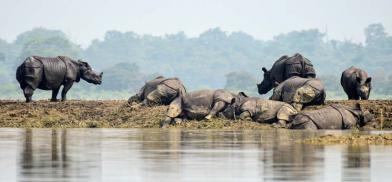116 animals perished in flooded Kaziranga park so far, 143 rescued
With over 90 per cent of land and forest areas in Assam's Kaziranga National Park flooded by rainwater, at least 116 wild animals have been killed so far due to drowning or vehicle-hits even as 143 animals have been rescued, officials said on Tuesday

With over 90 per cent of land and forest areas in Assam's Kaziranga National Park flooded by rainwater, at least 116 wild animals have been killed so far due to drowning or vehicle-hits even as 143 animals have been rescued, officials said on Tuesday. Established in 1908, the Kaziranga National Park, a UNESCO World Heritage site since 1985, is home to more than 2,200 one-horned Indian rhinoceros, approximately two-thirds of the total world population.
Officials of the Forest Department and Kaziranga Park said many tigers and rhinos had strayed into nearby villages and higher locations due to flooding of their habitats.
Park and Assam State Disaster Management Authority (ASDMA) officials said over 90 per cent of the park's 430 sq km area was now flooded, with traffic movement on the National Highway-37 near Kaziranga now suspended.
According to the officials, 11 rhinos, 88 hog deer, seven wild boars, four wild buffaloes, two swamp deer, two porcupines and one sambar and one python had so far perished in the floodwater or after hits by vehicles on the National Highway-37.
Of the rescued animals, 110 were hog deer, four tigers, two rhinos, 17 pythons, and three turtles.
The officials said that 16 hog deers were killed during treatment while 117 animals were released into the forest area after they were treated.
Park Director P. Sivakumar said that rising water level in the park areas had forced three sub-adult tigers to stray into a goat-shed in Kandolimari village and nearby areas.
"Subsequently, the tigers have already been driven back into the park area. All-out efforts were made to take care the animals in the entire Kaziranga National Park," Sivakumar told IANS over phone.
Besides Kaziranga National Park, located on the edge of the eastern Himalayan biodiversity hotspots of Golaghat and Nagaon districts, the Manas and R.G. Orang national parks, the Pabitora wildlife and the Tinsukia wildlife sanctuaries were also affected and a large number of wild animals marooned.
Each year, the monsoon floods inundate the National Park, forcing a large number of wild animals to leave the safety of the park and head towards the nearby hills in Karbi Anglong district by crossing National Highway-37 that passes near the park's boundary.
Of the 223 camps of forest personnel guarding the park, 73 have been inundated and six others vacated due to rising water levels.
The heavy monsoon rains over the past one month have led to massive flooding of the north-eastern state of Assam, inundating 2,254 villages and affecting around 25 lakh people and 109,600 hectares of crop area in 24 of the 33 districts.
According to ASDMA officials, the flood fury had resulted in 85 deaths so far in 21 districts, whereas 26 others were killed in separate landslides in different parts of Assam, specially in the southern region of the state since May 22. (IANS)









Post a Comment